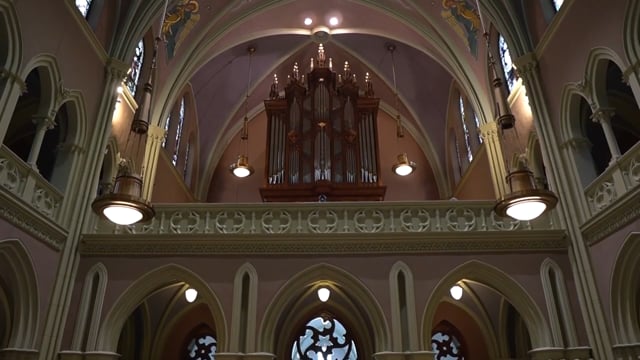
Taylor & Boody Organbuilders, Staunton, Virginia, has completed a new organ for Ancilla Domini Chapel, Plymouth, Indiana. Their Opus 83 comprises 36 stops, 52 ranks, 2,486 pipes across two manuals and pedal.
The case of the organ is modeled after 17th- and 18th-century Dutch instruments. It is constructed of white oak and stands 34 feet tall to the top of the center spire. All of the case decoration is reflective of the sanctuary, and especially ornate high altar. The façade contains pipes from the Hauptwerk 16′ Principal, down to low F-sharp, as well as the Oberwerk 8′ Principal. Behind it, at impost level, sit the two large windchests of the Hauptwerk division. Located above that, in the center, are the Oberwerk windchests. The Pedal is housed in a separate, two-tiered open case that stands behind the main case.
The specification provides a variety of 16- and 8-foot stops in each division, as well as complete choruses and a plethora of flutes and mutations. The Oberwerk’s high-tin 8′ Principal in façade is modeled after 18th-century examples, and its instrumental speech is the perfect foil to the Hauptwerk’s hammered lead 8′ Octave, whose dark, vocale sounds recall an earlier era. The Hauptwerk is lent gravitas by its full-compass 16′ Principal. The 8′ Holzflöte of the Oberwerk is a tapered wooden stop that sings from its position high atop the organ.
A variety of reeds distinguish Opus 83. The German-faced shallots help relate the sound of the dark and covered Trompets of the Hauptwerk to the brash and noisy 8′ Trompet that cries from the Oberwerk. The room demands a 32-foot pedal reed, and the Pedal Fagott can be heard under full organ, or used under just 8-foot stops. The woody and clarinet-like Dulcian, the strident Vox Humana, and the piquant Cornett provide an array of accompanimental and solo possibilities.
The key and stop action of the organ are completely mechanical, though the utility of the organ has been augmented by a combination action and sequencer by Solid State Organ Systems. Carbon fiber trackers are used throughout the instrument.
The wind for the organ is provided by three large wedge bellows, located in a room behind the back wall of the gallery. The entire organ plays on 80mm (3-1/8 inches) wind pressure. Though normally blower-winded, the organ can also be foot-pumped. The tremulant affects the entire organ, and wind stabilizers can be engaged to calm the lively wind.
Taylor & Boody Opus 83 is featured on the cover of the January 2024 issue of The Diapason.
For information: https://www.taylorandboody.com/
Other organ builder news:







